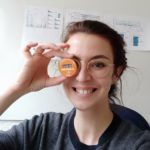Lien vers Pubmed [PMID] – 25801028
Cell Rep 2015 Mar; 10(11): 1913-24
Genomic rearrangements are a major source of evolutionary divergence in eukaryotic genomes, a cause of genetic diseases and a hallmark of tumor cell progression, yet the mechanisms underlying their occurrence and evolutionary fixation are poorly understood. Statistical associations between breakpoints and specific genomic features suggest that genomes may contain elusive “fragile regions” with a higher propensity for breakage. Here, we use ancestral genome reconstructions to demonstrate a near-perfect correlation between gene density and evolutionary rearrangement breakpoints. Simulations based on functional features in the human genome show that this pattern is best explained as the outcome of DNA breaks that occur in open chromatin regions coming into 3D contact in the nucleus. Our model explains how rearrangements reorganize the order of genes in an evolutionary neutral fashion and provides a basis for understanding the susceptibility of “fragile regions” to breakage.

